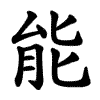能
- to be able, to be capable, to have the ability;
Etymology
能 was originally a pictograph, depicting a large animal with legs. The two 匕 components on the right side are thought to represent limbs.
Scholars have debated which animal it represents. The most common interpretation is that it depicts a bear, since 熊 (bear, 웅) incorporates 能 in its structure. In this reading, 能 was originally the base form of 熊.
Later, the character was borrowed for the abstract sense “to be able, capable.” From this, it developed into the modern meanings of ability, competence, talent.
Notably, 能 is most often used when the ability in question implies doing something difficult or impressive, or regaining a lost ability.
Usage in Korean
In modern Korean, 능 (能) is central in words relating to capacity and ability:
능력 (能力) – ability, capability
가능 (可能) – possibility, feasible
재능 (才能) – talent, gift
성능 (性能) – performance (of a machine or device)
무능 (無能) – incompetence
유능 (有能) – competent, talented
Words that derived from 能
Additional notes
In Old Korean and Middle Korean, 能 was usually read as “siryeo” or “siryeogom,” under the influence of 得 (silheo, “to be able, to obtain”).
- 戈月心心 (IBPP)
- ⿰ 䏍 𫧇
